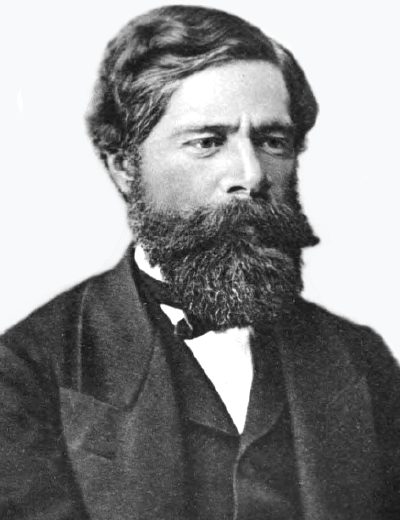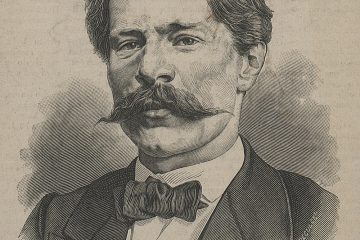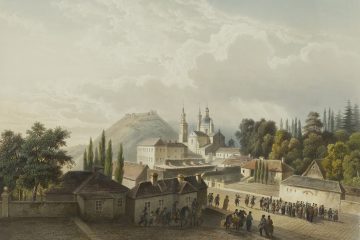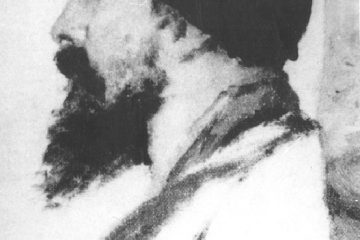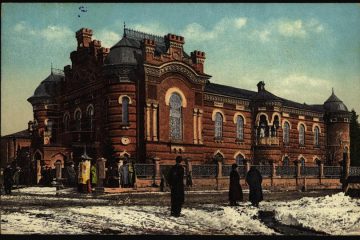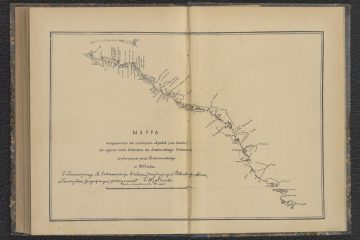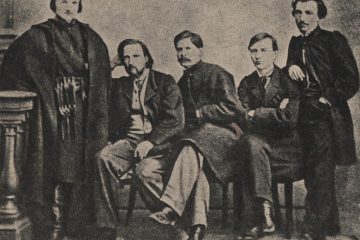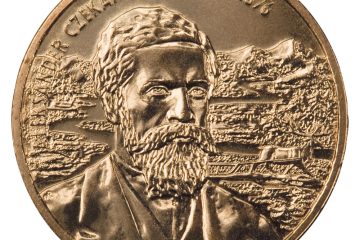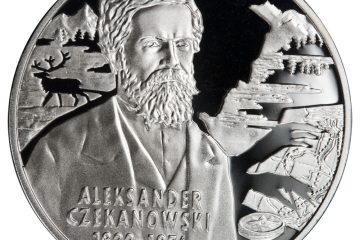Aleksander Czekanowski - discoverer of Siberian Traps
Author: dr hab. Mariusz Kulik
Aleksander Piotr Czekanowski (1833-1876) – geologist, exile, explorer of Siberia
He was born into a noble family on 12 December 1833 in Krzemieniec, as the son of Wawrzyniec, the owner of a local guesthouse, and Joanna, née Gostell. He finished secondary school in Kiev, and then enrolled in the Faculty of Medicine at the university in that city. During his studies he became fascinated by natural sciences, above all geology, which was influenced by the works of professors at the university and his contacts with the university in Dorpat (now Tartu), to which Czekanowski moved in 1855. There he met his later collaborators: Benedict Dybowski and Friedrich Schmidt (future member of the Imperial Academy of Sciences). In Dorpat he worked on identifying and systematising the university petrographic collections. In 1856-1857, with the aforementioned Fryderyk Schmidt, as well as Jan Nieszkowski and Gustaw Rupniewski, he visited Estonia, acquiring skills which he believed he would use in his work on the geology of Podolia. However, due to lack of funds, he interrupted his studies and in 1857 returned to Kiev, where he began to mark and systematise the university’s palaeontological collection, as he had done in Dorpat. He also did various commissioned work for the local statistics committee.
Czekanowski’s flat in Kiev was the venue for youth meetings attended by Benedykt Dybowski, a member of the insurrectionary National Government. The host, suspected of taking part in the January Uprising, was imprisoned in 1863 and then sent to Siberia for 12 years of hard labour. During his journey to exile, using a provisional magnifying glass made from the bottom of a carafe, he collected various natural specimens (insects, geological samples), which he gathered in self-made caskets. Those collections later were passed on to his friend from studies in Dorpat Friedrich Schmidt.
On his way to Siberia, Czekanowski fell ill with typhus, which caused additional health complications that might lead to his later periodic depressive states (known at the time as melancholia). However, although under-treated, he moved on and in 1865 arrived in Irkutsk, from where he was sent to Sivakova and then to Darasun on the Zabaikal. During this stage he was looked after by Leon Dąbrowski (also a fellow student in Dorpat) and Benedykt Dybowski, who also practised medicine on the side. The latter tried to involve his friend in the exiled group of researchers studying the nature of Lake Baikal, but Czekanowski was unable to work as a team. He was soon transferred to the surroundings of Bracki Ostrov, to the Angara cataracts, near the village of Paduń. At this time Czekanowski began his geological studies of the so-called Angara Land. He made meteorological observations, using instruments of his own invention to study, inter alia, the mechanism of winds.
During this period, he met Friedrich Schmidt, who was travelling in Siberia and who purchased from him the aforementioned collection for the Imperial Academy of Sciences and ordered further collections. He also provided his friend with books. In 1868, Schmidt obtained the permission to move Czekanowski to Irkutsk, where he became a volunteer at the branch of the Imperial Geographical Society headed by General Bolesław Kukiel. In his new environment, he recovered, regained his former energy and organised the existing collections of the society’s branch. With the help of other exiles (Dybowski, Hartung, Ekert, Czerski), he carried out extensive field research; his first scientific work was a geological description of the Irkutsk province. Czekanowski collected in it the results of previous research and related them to his own, which brought him in 1870 the small gold medal of the Imperial Geographical Society. The work, published in print in 1874, proved the need for further research into unexplored areas of Siberia. During his exploration of the Irkutsk province, Czekanowski discovered rich fossil deposits of Jurassic flora at Ust’ Belay on the Angara River. The discovery was so famous and the palaeontological collections so interesting that they became the basis for the work of Professor Heer of Zurich.
In 1871, Czekanowski with Dybowski, Godlewski, Wroński and Neuman (an astronomer from Dorpat) set off for the Sajan Mountains on the border of Mongolia. Encouraged by their success, Czekanowski decided to explore the entire East Siberian Highlands, between the valleys of the great rivers Yenisei and Lena. A dissertation on this subject, written with Schmidt, gained the approval of the Imperial Geographical Society. In 1873, Czekanowski set off on another expedition, this time as its leader, which crossed the Katunga valley (over a distance of about 2,300 versts), reached the Yenisey River and returned to Irkutsk. Its members travelled in the Tunguz caravan through areas in northern Siberia, exploring the mountains and basins of the Oleniok and Wiluj rivers. They travelled part of the route (about 1,700 versts) on the backs of reindeer and on a raft (2 June-13 September). The raft trip was interrupted by ice appearing on the Oleniok River, and the researchers continued their journey by sledge. That way they reached the mouth of the Oleniok and then through the mouth of the Lena to Jana. They reached Verkhoyansk and Yakutsk and reached Irkutsk on 5 January. In Yakutsk Czekanowski was offered by the Imperial Geographical Society to extend the expedition by a year and explore the Anabar and Chatanga rivers. However, he did not accept it; he had his own plans – he was interested in the lower part of the Lena and its estuary from a geological point of view. In 1875, he went there on his own, with the help of donations and loans. He was accompanied on the journey by Zygmunt Węgłowski (a former insurgent, student of the Równe Gymnasium and Kiev University). They left Irkutsk on 15 May 1875, and two weeks later they reached Yakutsk, from where they travelled down the Lena by large boat. On 27 July, they changed to reindeer backs, crossed the watershed between Oleniok and the Lena rivers, to the mouth of which they were aiming. On 26 August, they reached Mount Karamchat located near the Glacial Ocean. They camped near the graveyard of a naval expedition that had searched for the so-called Northern Route in the 18th century. Urged on by the approaching winter, they explored the Lena delta and on 6 September set off on their return journey on a reindeer-drawn sleigh. On 18 September, they reached the Lena River, and via Verkhoyansk and Yakutsk they reached Irkutsk on 20 December 1875. During an expedition lasting seven months they travelled over 11,000 kilometres. They brought back abundant collections: 1500 palaeontological, 3000 botanical, 7000 entomological specimens.
His travels and research brought Czekanowski fame as well as recognition from the authorities. The Imperial Geographical Society obtained an amnesty for him and invited him to St. Petersburg to work on the results of his expeditions. He moved into the Mineralogical Museum of the Academy of Sciences (as custodian) and took up drawing maps and compiling his collection, which he deposited at the academy. He determined the composition of the Siberian fauna and flora, made detailed measurements of the duration, strength and growth of trees in the areas he visited. During his research trip to Stockholm, he compared geological specimens from Spitsbergen with his own findings. In the autumn of 1876, he prepared a paper summarising his three expeditions, which was intended to justify the organisation of further research in Siberia.
Unfortunately, his depression returned. Czekanowski died in St. Petersburg on 18 October 1876, as a result of kidney failure (the medical report suggested ammonia poisoning).
In three years, he travelled 25,000 kilometres in eastern Siberia. His vitality, intelligence and perceptiveness, as well as his great affection for the indigenous inhabitants – the Tunguzians – all contributed to his work. His collections and observations, particularly geological ones, were used by a number of scholars in their work. The maps drawn up by Czekanowski complemented the topography of Asian Russia.
Bibliography
Kijas A., Polacy w Rosji od XVII wieku do 1917 roku. Słownik biograficzny, Warszawa–Poznań 2000, pp. 59–60.
Słabczyński T., Encyklopedia odkryć i odkrywców, Warszawa 2004, pp. 184–186.
Turkowski T., Czekanowski Aleksander, PSB, vol. 4, pp. 321–323.
Wójcik Z., Udział Polaków w rozpoznaniu przyrody Syberii, [in:] Polacy w nauce, gospodarce i administracji na Syberii w XIX i na początku XX wieku, Wrocław 2007, pp. 636–656.
Map
Miejsce urodzenia
Krzemieniec, Obwód tarnopolski, Ukraina
Nauka w gimnazjum, studia lekarskie na Uniwersytecie, praca na uczelni
Kijów, Ukraina
Studia w Dorpacie, praca na uczelni
Tartu, Estonia
Zesłanie na Syberię, pracownik w Oddziale Cesarskiego Towarzystwa Geograficznego
Irkuck, Rosja
Zesłanie na Syberię
Darasun, Kraj Zabajkalski, Rosja
Zesłanie na Syberię
Bratsk, Rosja
Wyprawa w 1871 roku
Góry Sajańskie, Kraj Krasnojarski, Rosja
Wyprawa badawcza
Wyżyna Środkowosyberyjska, Kraj Krasnojarski, Rosja
Obszar wypraw z 1873 i 1875 roku
Jakucja, Rosja
Miejsce pracy w Muzeum Mineralogicznym Akademii Nauk, miejsce śmierci
Petersburg, Rosja
Miejsce podróży naukowej
Sztokholm, Szwecja
